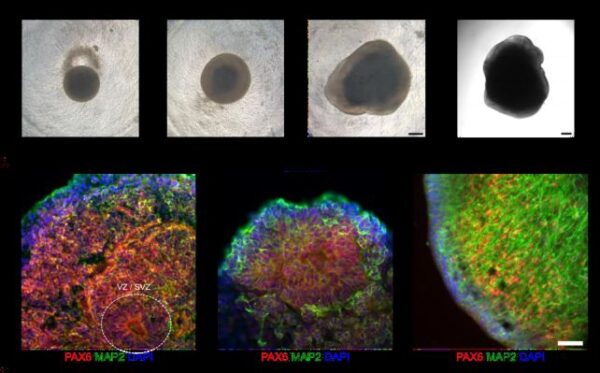Scientists created a functional computer from human brain tissue
- December 11, 2023
- 0
There is no computer even remotely as powerful and complex as the human brain. The masses of tissue in our skulls can only process information at a speed
There is no computer even remotely as powerful and complex as the human brain. The masses of tissue in our skulls can only process information at a speed

There is no computer even remotely as powerful and complex as the human brain. The masses of tissue in our skulls can only process information at a speed and speed beyond the power of computer technology. The key to the brain’s success is the efficiency of the neuron as both a processor and memory device, as opposed to physically separated units in most modern computing devices. There have been many attempts to make the computer more brain-like, but a new initiative goes one step further by integrating real human brain tissue with electronics.
It’s called Brainoware and it works. A team led by engineer Feng Guo of Indiana University in Bloomington gave it tasks such as speech recognition and prediction of nonlinear equations. It was slightly less accurate than an AI-powered hardware computer, but the research represents an important first step in a new type of computer architecture. But while Guo and his colleagues followed ethical principles in the development of Brainoware, several researchers from Johns Hopkins University note in a related commentary: Nature Electronics The importance of keeping ethical considerations in mind when further expanding this technology.
Lena Smirnova, Brian Caffo and Eric K. Johnson, who were not involved in the research, caution: ‘As the complexity of these organoid systems increases, it is imperative that the community examine the many neuroethical issues surrounding biocomputer systems, including human neural tissue.’ The human brain is incredibly amazing, containing on average about 86 billion neurons and up to a quadrillion synapses. Each neuron is connected to 10,000 other neurons that are constantly firing and communicating with each other.
To date, our best attempts to simulate brain activity in an artificial system have only scratched the surface. In 2013, Riken’s Computer K, then one of the most powerful supercomputers in the world, attempted to simulate the brain. With 82,944 processors and one petabyte of main memory, it took 40 minutes to simulate one second of activity of 1.73 billion neurons (about one to two percent of the brain) connected by 10.4 trillion synapses.

In recent years, scientists and engineers have been trying to get closer to the brain’s capabilities by developing hardware and algorithms that mimic the brain’s structure and way of working. This method, known as neuromorphic computing, is developing, but training artificial neural networks is energy-intensive and time-consuming. Guo and his colleagues sought a different approach using real human brain tissue grown in the laboratory. Human pluripotent stem cells were induced to develop into different types of brain cells, which organized themselves into three-dimensional mini-brains, complete with connections and structures, called organoids.
These are not real brains, they are just tissue formations that have no resemblance to thought, emotion or consciousness. They are useful for studying how the brain develops and works without studying a real person in depth.
Brainoware consists of brain organoids connected to a high-density array of microelectrodes using a type of artificial neural network known as reservoir computing. Electrical stimulation transfers information to the organoid, a reservoir where that information is processed before Brainoware broadcasts its calculations in the form of neural activity. Conventional computer hardware is used for input and output levels. These layers had to be trained to work with the organoid, and the output layer read the neural data and make classifications or predictions based on the input data.
To demonstrate the system, the researchers fed the Brainoware 240 audio recordings of eight male speakers uttering Japanese vowels and asked them to identify a specific person’s voice. They started with a pure organoid; After just two days of training, Brainoware was able to identify the speaker with 78 percent accuracy.
They also asked Brainoware to predict the Hénon map, a dynamic system that exhibits chaotic behavior. They left it unattended to learn for four days (each day representing a learning period) and found that it could predict the map with better accuracy than an artificial neural network, without a long block of short-term memory.
Brainoware was slightly less accurate than artificial neural networks with long short-term memory, but each of these networks went through 50 training epochs. Brainoware achieved roughly the same results in less than 10 percent of the training time.
“Due to the high plasticity and adaptability of organoids, Brainoware has the flexibility to change and rearrange in response to electrical stimulation, underscoring its adaptive backup computational capacity,” the researchers wrote.
There are significant limitations, including the problem of keeping organoids alive and healthy, as well as the power consumption levels of peripherals. But considering ethical considerations, Brainoware has implications not only for computing but also for understanding the mysteries of the human brain.
“General biocomputing systems may take decades to build, but this research is likely to provide fundamental insights into learning mechanisms, neural development, and cognitive consequences of neurodegenerative diseases,” Smirnova, Caffo, and Johnson write. “It may also help develop preclinical models of cognitive impairment to test new treatment methods.”
Source: Port Altele
As an experienced journalist and author, Mary has been reporting on the latest news and trends for over 5 years. With a passion for uncovering the stories behind the headlines, Mary has earned a reputation as a trusted voice in the world of journalism. Her writing style is insightful, engaging and thought-provoking, as she takes a deep dive into the most pressing issues of our time.